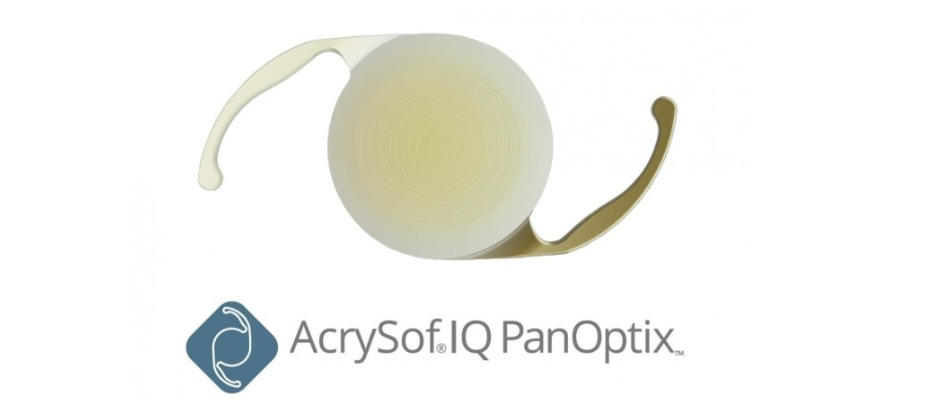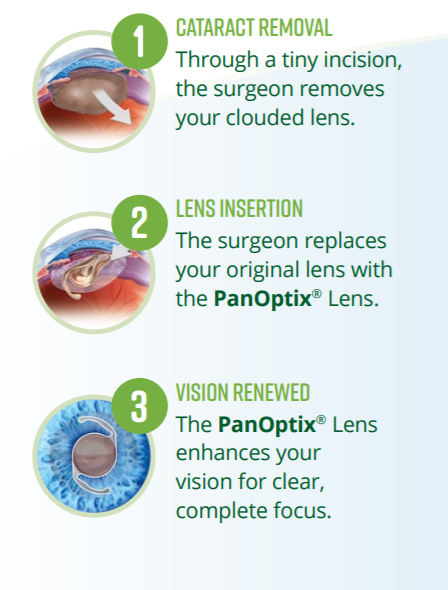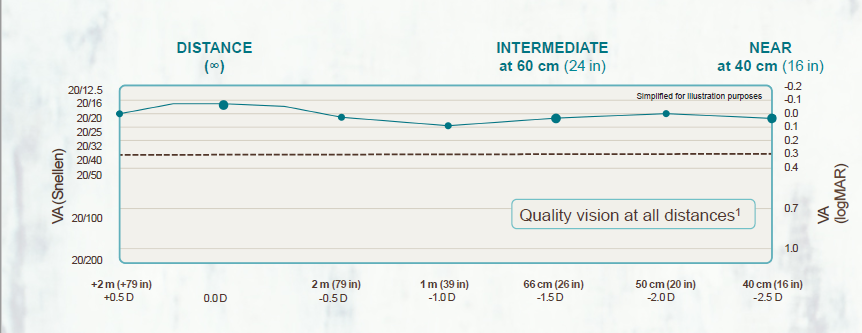Blog post by: Eye Physicians of Long Beach

Have you heard the news? On August 27th, the FDA announced its approval of Alcon’s AcrySofIQ PanOptix Trifocal IOL. This is great news for people having cataract surgery. Keep reading to find out what this means for you!
What are the different types of intraocular lenses (IOLs)?
When you have cataract surgery, the old cloudy lens is removed and a new clear lens is implanted. Before you have cataract surgery, it’s important to review IOLs with your eye doctor.
You should learn about the different lenses before you decide which is best for you. There are several kinds of IOLs to consider.
When choosing an IOL, you should think about what kind of lifestyle you lead. Do you want to live a life without glasses?
Are you okay with spending more for an advanced technology lens option? These are the types of intraocular lenses available to you:
Monofocal IOL:
Monofocal IOLs are the basic option when it comes to IOLs. If you are on a budget, these are a good option. There are other reasons why sometimes monofocal lenses are the best option.
They are the only IOL that Medicare will usually cover. With a monofocal IOL, each eye has one focusing distance.
It can be set for up close, mid-range, or distance vision. Most people use a monofocal IOL for distance vision and use glasses for up-close work.
Multifocal IOL:
Multifocal IOLs are an advanced technology lens option. These are better for people who want to see without glasses after cataract surgery.
Because of the advanced technology, they are also more expensive than the basic monofocal IOL. These can simultaneously correct astigmatism.
Multifocal IOLs are designed to provide both distance and up-close vision at the same time. This is possible because the lens has different zones set into it.
Although it sounds tricky, this is something the brain adapts to easily over time.
Accommodating IOL:
Like multifocal IOLs, the accommodating IOL is also an advanced technology lens. The big difference between them is how the accommodating IOL moves inside your eye. These can also simultaneously correct astigmatism.
Accommodating IOLs change shape inside your eye, allowing for focus at different distances. This is the most natural kind of IOL, as it’s the closest to how a natural lens moves inside your eye.
Toric IOL:
Toric IOLs are designed for people with astigmatism. With astigmatism, it means that the cornea or lens has an uneven curvature. The eye or parts of it are essentially like a football. This results in blurry vision.
Toric IOLs correct this refractive error. With a toric IOL, each eye has one focusing distance. It can be set for up close, mid-range, or distance vision. Most people use a toric IOL for distance vision and use glasses for up-close work.
What is the Trifocal IOL?
The newly FDA approved PanOptix trifocal IOL is different from all of the above IOLs. This lens is in a class of its own. Even the advanced technology IOLs-multifocal, accommodating, and toric, only provide vision at two distances.

PanOptix is considered a trifocal IOL but it really performs more like a quadrifocal. It has changed the IOL landscape for one reason: it provides better vision for most distances. PanOptix delivers vision for near, intermediate, and distance vision.
Before PanOptix, this was never possible. There was a “gap” in vision between near and distance vision for cataract surgery patients. It was this intermediate vision that was missing.
Until now!
PanOptix is the first lens to split light at three points. With other IOL options, light could only be split into two points.
The PanOptix IOL uses proprietary ENLIGHTEN Optical Technology. This is the technology that allows the trifocal IOL to optimize for intermediate vision without compromising near and distance vision.
The lens design was designed in such a way that the focal point of 120 cm is redistributed to the eye’s distance focal point. With a 3 mm pupil diameter, the PanOptix IOL transmits 88% of light to the retina even at a 3 mm pupil. This rivals the very best lenses at light transmission to the retina which is the area where it matters.

When compared to other advanced technology IOL options, the PanOptix IOL is the only single-lens design that allows for a near and intermediate focal point without compromising any distance vision.
PanOptix is the only trifocal approved in the US. Eventually, other trifocals will come to market but the traditional trifocal requires a sequential diffractive order approach to create an intermediate focal point located at 2 times the distance of the near focal point.
These IOLs have a near focal point at ~40 cm with an intermediate focal point at about 80 cm.
The most common intermediate vision activities are typically performed at a relaxed arm’s length, about 60 cm for the average population and up-close at 40 cm. Using non-sequential diffractive optics, the PanOptix® IOL is the only single-lens design that allows for a 40 cm (16 inches) (near) and 60 cm (24 inches) (intermediate) focal point without compromising distance vision.
PanOptix has its intermediate at an ideal point which is usually a relaxed arm’s length away. As if that was not enough, PanOptix performs incredibly well at distance and between distance and the 60 cm.
It also needed to be able to balance how the IOL performed in low light situations without causing visual disturbances. Through some optical creativity, PanOptix manages to increase the number of light rays focused from distance by shifting some of the intermediate focal point’s light energy to distance.
As a result, they chose a diffractive optic diameter of 4.5 mm for the PanOptix IOL. Using a 4.5 mm diffractive zone provides the full trifocal experience for most patients, no matter what kind of lighting conditions they may be in.
This lens performs so well that on a defocused curve the lens performs between 20/20 and 20/25 for all distances measured.

The central zone of the PanOptix IOL is intermediate, rather than distance. This provides the best distribution of light through the three focal points.
The light distributes 50% for distance, 25% for intermediate, and 25% for near. The lens measures 6mm in diameter.
Outside of the 4.5 mm diffractive region, the lens is purely refractive and directs the light energy to distance only. This should enhance performance under low illumination and nighttime vision. This lens comes even in a toric form capable of correcting existing astigmatism.
Loss in contrast sensitivity is a known risk associated with multifocal IOLs. However, data shows that the PanOptix® IOL delivers excellent contrast sensitivity comparable to a monofocal IOL at 6 months — in both dim and bright conditions.
Halos and glare are still a possibility with this lens as it can happen with any lens. Of the patients who reported visual disturbances with PanOptix® IOL, 4.8% said they were bothered very much by starbursts (n=125), 2.4% by halos and 1.6% by glare.
Prior to surgery, patients should be informed of the possible risks and benefits of PanOptix® IOL implantation. This is a very low likelihood of unwanted images and from data collected 6 months post-op: Out of 127 patients, 99.2% would have had the same lens implanted again.
With this winning combination of light distribution, the trifocal IOL delivers seamless vision, no matter what you’re looking at, and in almost any lighting condition!
Trifocal IOL also available for presbyopia patients
By giving patients more IOL options, better vision is now more attainable. Besides cataract patients, the trifocal IOL is also available for presbyopia patients.
Presbyopia is a natural part of the aging process. As we age, the lenses of our eyes become less flexible. This makes it more difficult to see and focus on things up close.
By using the trifocal IOL during Refractive Lens Exchange, there’s no reason not to make the choice to have clear vision! The PanOptix trifocal IOL is built on Alcon’s proven AcrySof IQ IOL platform.
In fact, it’s already been implanted in more than 120 million eyes around the world! The FDA spends a significant amount of time evaluating these lenses and as a result, they usually get approval in other parts of the world first.
The PanOptix trifocal IOL is the first and only FDA approved trifocal lens and it has been used extensively throughout the rest of the world.
The PanOptix trifocal IOL has been available in Europe for several years. Time and time again, surgeons there choose the trifocal IOL over monofocal IOLs and other IOLs.
Trifocal IOL now available at Eye Physicians of Long Beach
Have cataracts? Considering a procedure to treat presbyopia?
You may be a candidate for the PanOptix trifocal IOL! The only way to know for sure is to see one of the expert doctors at Eye Physicians of Long Beach for a consultation.
Schedule an appointment at Eye Physicians of Long Beach in Long Beach, CA today! Isn’t it time you saw everything around you with perfect clarity?
